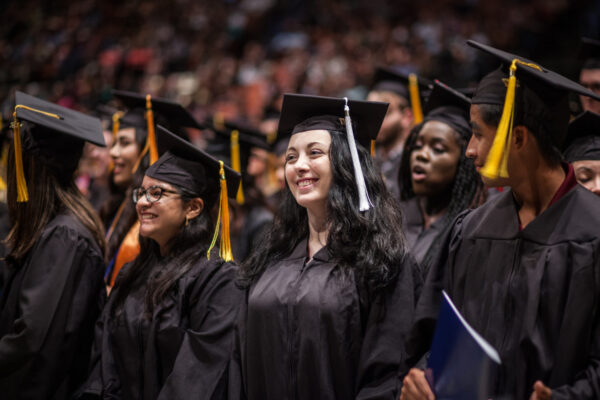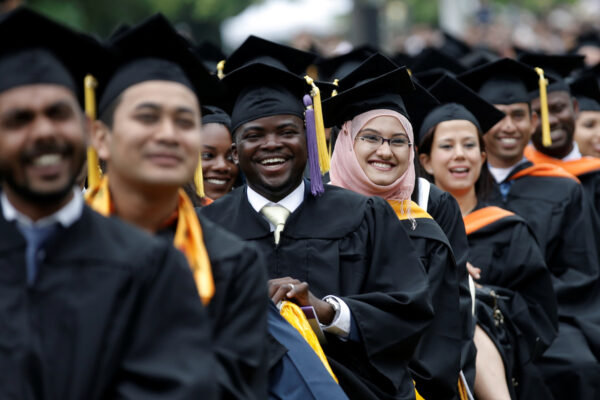By Russell Lowery-Hart. Dr. Lowery-Hart is president of Amarillo College, one of two recipients of the 2020 ACE/Fidelity Investments Award for Institutional Transformation. The award was created to recognize institutions that have responded to higher education challenges.
The Amarillo College reformation is an inspiring tale of courage, pain, uncertainty, risk-taking, and even fear. Yet, the foundation of our reformation is based on one important concept—love. We significantly increased learning and three-year completion rates (from 22 percent to 53 percent in just five years) by systemically and intentionally committing to the power of love.
In her thoughtful and personal work all about love, bell hooks offered a critical challenge that Amarillo College accepted. “All spheres of American life—politics, religion, the workplace, households, relations—should and could have as their foundation a love ethic.” When Amarillo College faced a significant budget crisis and enrollment decreases, we decided our path forward must be radically different that our past journey.
To be clear, rebuilding an entire college on the foundation of love was not easy in a higher education sector often devoid of it. We had to understand what it meant to love students to success. bell hooks knew our definitions of love were problematic and offered a profound challenge in reimagining love in a public sector. “The word love is often defined as a noun, yet … we would all love better if we used it as a verb.” (hooks, 2001, p. 4). At Amarillo College, our students helped us understand the actions that define love in an institution of higher learning.
We learned from listening to our students describe their perfect college that we had to thoughtfully build love into the fabric of our work. Love became the central theme of our strategic plan in 2015. We committed to loving our students, and each other, to success. We were equally committed to intentionally loving the students we had, rather than yearn for the students we used to have, or teach to the students we thought we had. We committed to actually meeting and knowing our students, and then building systems around the needs they identified.
Data defined our typical student. We met with her. Listened to her. Built our college around her. And, fell in love with her. We even named her—Maria. I’d like you to meet her: She is smart, dedicated, ambitious—and she needs us differently than our previous “traditional” students in higher education.
Maria (like most students in higher education across our country) is first-generation (70 percent of our students are); attends part-time (52 percent); and lives in the war zone of poverty (54 percent financial aid recipient). Maria is a 25-year-old Latinx mother of 1.2 kids, working two part-time jobs while attending AC. Our college is a minority-majority institution with 58 percent students of color.
Higher education was not built for Maria, and we spend millions of taxpayer dollars trying to train Maria to adapt to our antiquated traditions. By learning who our students are and listening to and understanding the reality of their educational attainment and completion journey, we transformed our institution and ourselves.

We built our culture of caring around three main tenets of a theory of change that our students told us were critical to their success. If AC 1) removes a life barrier, 2) in an accelerated learning platform, 3) within a deep and systemic culture of caring that loves our student to success—then students will complete and graduate with the skills and credentials needed to earn a living wage.

Our students told us that life barriers were their greatest hurdle. The top 10 barriers to classroom success had nothing to do with the classroom—they were life-related. Initially, we were so focused on academics that we failed to realize the more powerful and debilitating barrier: poverty.
Our work with Donna Beegle helped us understand poverty and its barriers. Survey data from Sara Goldrick-Rab and her case student on Amarillo College through the Hope Center for College, Community, and Justice at Temple University helped us know how pervasive poverty and its barriers are for our students. Love demanded action, and Amarillo College responded.
The Advocacy & Resource Center (ARC) is the hub of AC’s system designed to eradicate poverty barriers. The ARC collaborates with over 60 local nonprofits to help our students meet life’s basic needs. Through these partnerships, students have access to funds for transportation, housing, utilities, and childcare. With three social workers, robust emergency aid support from our Amarillo College Foundation and community supporters, and an entire college committed to a culture of caring, we served nearly 3,000 students in one academic year.
Because Maria faces so many life barriers, time to degree is particularly important. With our commitment to adapting to our student, we reimagined how our students engaged with learning. After a site visit to Odessa College, where we learned students actually performed better in accelerated experiences, we scaled over 85 percent of our courses in accelerated formats. Learning increased. Time to degree decreased. All of our Marias were graduating at historic levels.
First-generation students like Maria do not have a support system to help them navigate our higher education vernacular, abbreviations, acronyms, and “policies and procedures.” We knew our entire college had to be committed to helping them. Amarillo College built a culture of caring that empowered every single employee to privilege the needs of our students. We started meeting students in the parking lots and walking them to their destinations. We call our students to check on them. We empowered our students to write the values for the college and then integrated those values into every job description and hiring process.
It worked. Our enrollment increased, retention and completion rates increased, and even our employee work satisfaction increased. Academic “traditions” did not create these necessary solutions for students—love did.
As a graduate student turned professor and then administrator, I often heard musings that students were at fault if they could not navigate our bureaucracies, or learn in our classrooms, or build their networks. We typically do not accept responsibility for student failures (yet, we are quick to take credit for their successes). In Amarillo, Texas, and at Amarillo College, our regional economy could not afford failure, no matter who was a fault.
At AC, we understood the responsibility to change the economic outlook for our community rested on our ability to ensure students learned and graduated with a certificate or degree. In Triumph of the City, Edward Glaser linked economic progress to education attainment. We understood our community’s future was linked to our ability to love our students to success. Education attainment was the imperative. Love was the conduit.
Our students told us the perfect college was relational, inclusive, honoring, helpful—loving. They described the perfect college where they did not fear getting lost, or being trapped in vernacular that made no sense, or meeting professors who were more interested in power than effectiveness. Our students described a college that cared deeply about the success of its students (and employees). After listening to one group of students after another repeat these themes of love and caring, I was reminded of Scott Peck’s work in The Road Less Travelled. He wrote about love as an act of will—a verb—an intentional action.
Amarillo College faculty, staff, and administrators knew it would be a difficult journey, but we could rebuild our college on a foundation of love and significantly improve student learning and completion, and reshape our regional economy. bell hooks challenged us that “the path to love is not arduous or hidden, but we must choose to take the first step.”
At Amarillo College, our first step into love was listening too and understanding our students. As a result, we are loving Maria and Amarillo to success. When we love our students from enrollment to graduation, they thrive in school, achieve their educational dreams, and support the economic future of our community. Love is the very verb to save higher education from itself. Embrace it. Build it. Share it.
References
Glaeser, E. L. (2011). Triumph of the city: How our greatest invention makes us richer, smarter, greener, healthier, and happier. New York: Penguin Press.
hooks, bell (2001.) all about love: new visions. New York: HarperCollins.
Peck, M. S. (1978). The road less traveled: A new psychology of love, traditional values, and spiritual growth. New York: Simon and Schuster.
If you have any questions or comments about this blog post, please contact us.


